Python 基础(十三) | 机器学习 sklearn 库详解与应用
⭐本专栏旨在对 Python 的基础语法进行详解,精炼地总结语法中的重点,详解难点,面向零基础及入门的学习者,通过专栏的学习可以熟练掌握 python 编程,同时为后续的数据分析,机器学习及深度学习的代码能力打下坚实的基础。
🔥本文已收录于 Python 基础系列专栏: Python基础系列教程 欢迎订阅,持续更新。
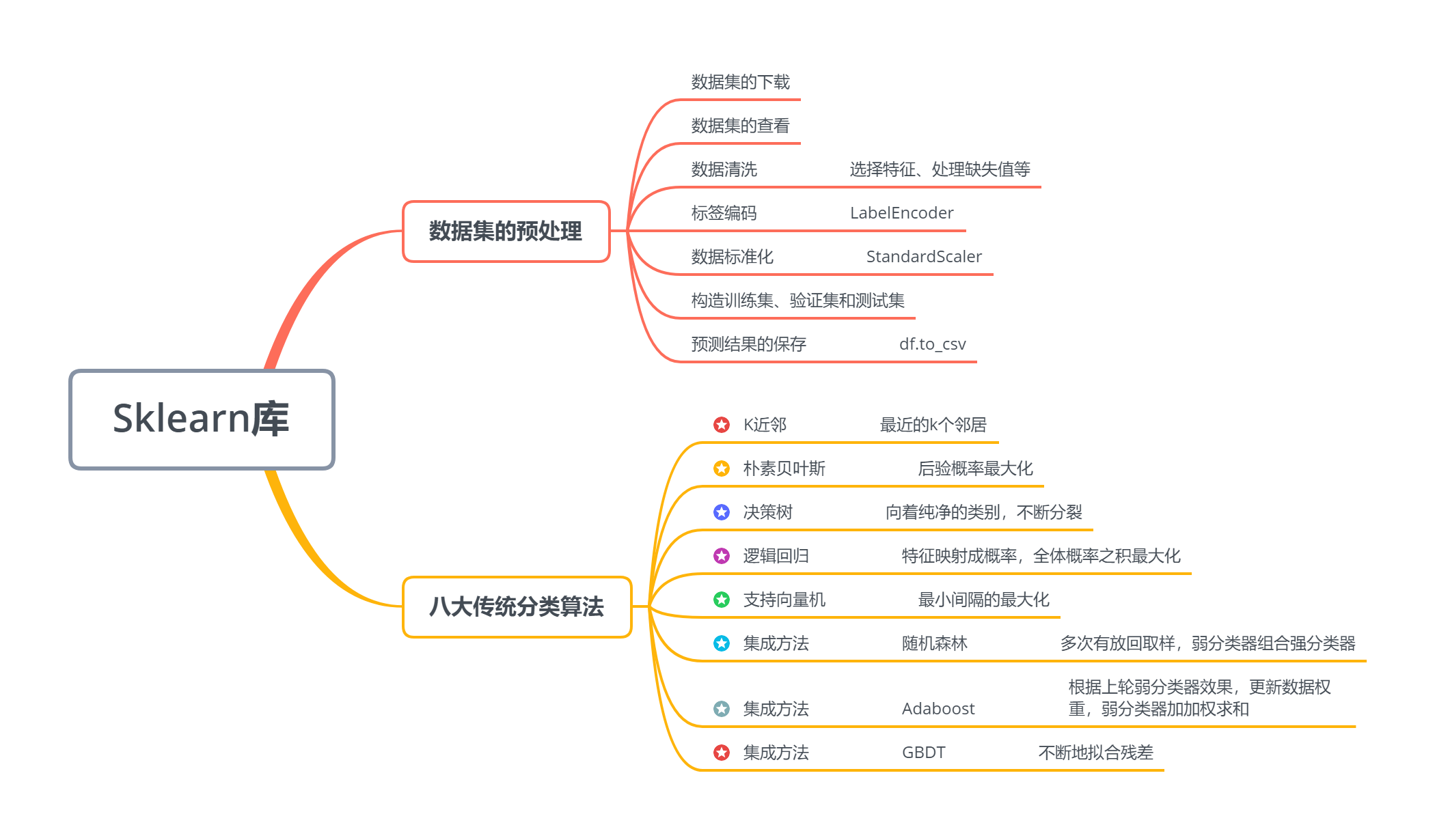
scikit-learn 库是当今最流行的机器学习算法库之一
可用来解决分类与回归问题
本章以鸢尾花数据集为例,简单了解八大传统机器学习分类算法的 sk-learn 实现
欲深入了解传统机器算法的原理和公式推导,请继续学习《统计学习方法》或《西瓜书》
13.0 鸢尾花数据集
【1】下载数据集
【2】数据集的查看
<div><style scoped>.dataframe tbody tr th:only-of-type {vertical-align: middle;}
</style>
<table border="1" class="dataframe"><thead><tr style="text-align: right;"><th></th><th>sepal_length</th><th>sepal_width</th><th>petal_length</th><th>petal_width</th><th>species</th></tr></thead><tbody><tr><th>0</th><td>5.1</td><td>3.5</td><td>1.4</td><td>0.2</td><td>setosa</td></tr><tr><th>1</th><td>4.9</td><td>3.0</td><td>1.4</td><td>0.2</td><td>setosa</td></tr><tr><th>2</th><td>4.7</td><td>3.2</td><td>1.3</td><td>0.2</td><td>setosa</td></tr><tr><th>3</th><td>4.6</td><td>3.1</td><td>1.5</td><td>0.2</td><td>setosa</td></tr><tr><th>4</th><td>5.0</td><td>3.6</td><td>1.4</td><td>0.2</td><td>setosa</td></tr></tbody></table>
</div>
<div><style scoped>.dataframe tbody tr th:only-of-type {vertical-align: middle;}
</style>
<table border="1" class="dataframe"><thead><tr style="text-align: right;"><th></th><th>sepal_length</th><th>sepal_width</th><th>petal_length</th><th>petal_width</th></tr></thead><tbody><tr><th>count</th><td>150.000000</td><td>150.000000</td><td>150.000000</td><td>150.000000</td></tr><tr><th>mean</th><td>5.843333</td><td>3.057333</td><td>3.758000</td><td>1.199333</td></tr><tr><th>std</th><td>0.828066</td><td>0.435866</td><td>1.765298</td><td>0.762238</td></tr><tr><th>min</th><td>4.300000</td><td>2.000000</td><td>1.000000</td><td>0.100000</td></tr><tr><th>25%</th><td>5.100000</td><td>2.800000</td><td>1.600000</td><td>0.300000</td></tr><tr><th>50%</th><td>5.800000</td><td>3.000000</td><td>4.350000</td><td>1.300000</td></tr><tr><th>75%</th><td>6.400000</td><td>3.300000</td><td>5.100000</td><td>1.800000</td></tr><tr><th>max</th><td>7.900000</td><td>4.400000</td><td>6.900000</td><td>2.500000</td></tr></tbody></table>
</div>
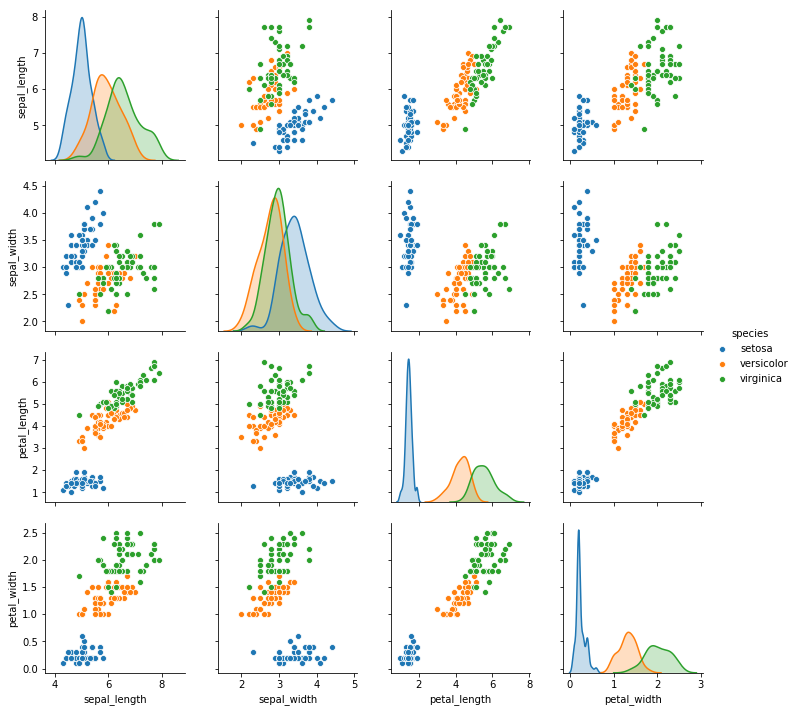
可见,花瓣的长度和宽度有非常好的相关性。而花萼的长宽效果不好,因此考虑对他们丢弃。
【3】数据清洗
<div><style scoped>.dataframe tbody tr th:only-of-type {vertical-align: middle;}
</style>
<table border="1" class="dataframe"><thead><tr style="text-align: right;"><th></th><th>petal_length</th><th>petal_width</th><th>species</th></tr></thead><tbody><tr><th>0</th><td>1.4</td><td>0.2</td><td>setosa</td></tr><tr><th>1</th><td>1.4</td><td>0.2</td><td>setosa</td></tr><tr><th>2</th><td>1.3</td><td>0.2</td><td>setosa</td></tr><tr><th>3</th><td>1.5</td><td>0.2</td><td>setosa</td></tr><tr><th>4</th><td>1.4</td><td>0.2</td><td>setosa</td></tr></tbody></table>
</div>
【4】标签编码
<div><style scoped>.dataframe tbody tr th:only-of-type {vertical-align: middle;}
</style>
<table border="1" class="dataframe"><thead><tr style="text-align: right;"><th></th><th>petal_length</th><th>petal_width</th><th>species</th></tr></thead><tbody><tr><th>0</th><td>1.4</td><td>0.2</td><td>0</td></tr><tr><th>1</th><td>1.4</td><td>0.2</td><td>0</td></tr><tr><th>2</th><td>1.3</td><td>0.2</td><td>0</td></tr><tr><th>3</th><td>1.5</td><td>0.2</td><td>0</td></tr><tr><th>4</th><td>1.4</td><td>0.2</td><td>0</td></tr><tr><th>5</th><td>1.7</td><td>0.4</td><td>0</td></tr><tr><th>6</th><td>1.4</td><td>0.3</td><td>0</td></tr><tr><th>7</th><td>1.5</td><td>0.2</td><td>0</td></tr><tr><th>8</th><td>1.4</td><td>0.2</td><td>0</td></tr><tr><th>9</th><td>1.5</td><td>0.1</td><td>0</td></tr><tr><th>10</th><td>1.5</td><td>0.2</td><td>0</td></tr><tr><th>11</th><td>1.6</td><td>0.2</td><td>0</td></tr><tr><th>12</th><td>1.4</td><td>0.1</td><td>0</td></tr><tr><th>13</th><td>1.1</td><td>0.1</td><td>0</td></tr><tr><th>14</th><td>1.2</td><td>0.2</td><td>0</td></tr><tr><th>15</th><td>1.5</td><td>0.4</td><td>0</td></tr><tr><th>16</th><td>1.3</td><td>0.4</td><td>0</td></tr><tr><th>17</th><td>1.4</td><td>0.3</td><td>0</td></tr><tr><th>18</th><td>1.7</td><td>0.3</td><td>0</td></tr><tr><th>19</th><td>1.5</td><td>0.3</td><td>0</td></tr><tr><th>20</th><td>1.7</td><td>0.2</td><td>0</td></tr><tr><th>21</th><td>1.5</td><td>0.4</td><td>0</td></tr><tr><th>22</th><td>1.0</td><td>0.2</td><td>0</td></tr><tr><th>23</th><td>1.7</td><td>0.5</td><td>0</td></tr><tr><th>24</th><td>1.9</td><td>0.2</td><td>0</td></tr><tr><th>25</th><td>1.6</td><td>0.2</td><td>0</td></tr><tr><th>26</th><td>1.6</td><td>0.4</td><td>0</td></tr><tr><th>27</th><td>1.5</td><td>0.2</td><td>0</td></tr><tr><th>28</th><td>1.4</td><td>0.2</td><td>0</td></tr><tr><th>29</th><td>1.6</td><td>0.2</td><td>0</td></tr><tr><th>...</th><td>...</td><td>...</td><td>...</td></tr><tr><th>120</th><td>5.7</td><td>2.3</td><td>2</td></tr><tr><th>121</th><td>4.9</td><td>2.0</td><td>2</td></tr><tr><th>122</th><td>6.7</td><td>2.0</td><td>2</td></tr><tr><th>123</th><td>4.9</td><td>1.8</td><td>2</td></tr><tr><th>124</th><td>5.7</td><td>2.1</td><td>2</td></tr><tr><th>125</th><td>6.0</td><td>1.8</td><td>2</td></tr><tr><th>126</th><td>4.8</td><td>1.8</td><td>2</td></tr><tr><th>127</th><td>4.9</td><td>1.8</td><td>2</td></tr><tr><th>128</th><td>5.6</td><td>2.1</td><td>2</td></tr><tr><th>129</th><td>5.8</td><td>1.6</td><td>2</td></tr><tr><th>130</th><td>6.1</td><td>1.9</td><td>2</td></tr><tr><th>131</th><td>6.4</td><td>2.0</td><td>2</td></tr><tr><th>132</th><td>5.6</td><td>2.2</td><td>2</td></tr><tr><th>133</th><td>5.1</td><td>1.5</td><td>2</td></tr><tr><th>134</th><td>5.6</td><td>1.4</td><td>2</td></tr><tr><th>135</th><td>6.1</td><td>2.3</td><td>2</td></tr><tr><th>136</th><td>5.6</td><td>2.4</td><td>2</td></tr><tr><th>137</th><td>5.5</td><td>1.8</td><td>2</td></tr><tr><th>138</th><td>4.8</td><td>1.8</td><td>2</td></tr><tr><th>139</th><td>5.4</td><td>2.1</td><td>2</td></tr><tr><th>140</th><td>5.6</td><td>2.4</td><td>2</td></tr><tr><th>141</th><td>5.1</td><td>2.3</td><td>2</td></tr><tr><th>142</th><td>5.1</td><td>1.9</td><td>2</td></tr><tr><th>143</th><td>5.9</td><td>2.3</td><td>2</td></tr><tr><th>144</th><td>5.7</td><td>2.5</td><td>2</td></tr><tr><th>145</th><td>5.2</td><td>2.3</td><td>2</td></tr><tr><th>146</th><td>5.0</td><td>1.9</td><td>2</td></tr><tr><th>147</th><td>5.2</td><td>2.0</td><td>2</td></tr><tr><th>148</th><td>5.4</td><td>2.3</td><td>2</td></tr><tr><th>149</th><td>5.1</td><td>1.8</td><td>2</td></tr></tbody></table><p>150 rows × 3 columns</p>
</div>
【5】数据集的标准化(本数据集特征比较接近,实际处理过程中未标准化)
<div><style scoped>.dataframe tbody tr th:only-of-type {vertical-align: middle;}
</style>
<table border="1" class="dataframe"><thead><tr style="text-align: right;"><th></th><th>petal_length</th><th>petal_width</th></tr></thead><tbody><tr><th>count</th><td>1.500000e+02</td><td>1.500000e+02</td></tr><tr><th>mean</th><td>-8.652338e-16</td><td>-4.662937e-16</td></tr><tr><th>std</th><td>1.003350e+00</td><td>1.003350e+00</td></tr><tr><th>min</th><td>-1.567576e+00</td><td>-1.447076e+00</td></tr><tr><th>25%</th><td>-1.226552e+00</td><td>-1.183812e+00</td></tr><tr><th>50%</th><td>3.364776e-01</td><td>1.325097e-01</td></tr><tr><th>75%</th><td>7.627583e-01</td><td>7.906707e-01</td></tr><tr><th>max</th><td>1.785832e+00</td><td>1.712096e+00</td></tr></tbody></table>
</div>
【6】构建训练集和测试集(本课暂不考虑验证集)
<div><style scoped>.dataframe tbody tr th:only-of-type {vertical-align: middle;}
</style>
<table border="1" class="dataframe"><thead><tr style="text-align: right;"><th></th><th>petal_length</th><th>petal_width</th><th>species</th></tr></thead><tbody><tr><th>3</th><td>1.5</td><td>0.2</td><td>0</td></tr><tr><th>111</th><td>5.3</td><td>1.9</td><td>2</td></tr><tr><th>24</th><td>1.9</td><td>0.2</td><td>0</td></tr><tr><th>5</th><td>1.7</td><td>0.4</td><td>0</td></tr><tr><th>92</th><td>4.0</td><td>1.2</td><td>1</td></tr></tbody></table>
</div>
<div><style scoped>.dataframe tbody tr th:only-of-type {vertical-align: middle;}
</style>
<table border="1" class="dataframe"><thead><tr style="text-align: right;"><th></th><th>petal_length</th><th>petal_width</th></tr></thead><tbody><tr><th>63</th><td>4.7</td><td>1.4</td></tr><tr><th>93</th><td>3.3</td><td>1.0</td></tr><tr><th>34</th><td>1.5</td><td>0.2</td></tr><tr><th>35</th><td>1.2</td><td>0.2</td></tr><tr><th>126</th><td>4.8</td><td>1.8</td></tr></tbody></table>
</div>
<div><style scoped>.dataframe tbody tr th:only-of-type {vertical-align: middle;}
</style>
<table border="1" class="dataframe"><thead><tr style="text-align: right;"><th></th><th>petal_length</th><th>petal_width</th></tr></thead><tbody><tr><th>3</th><td>1.5</td><td>0.2</td></tr><tr><th>111</th><td>5.3</td><td>1.9</td></tr><tr><th>24</th><td>1.9</td><td>0.2</td></tr><tr><th>5</th><td>1.7</td><td>0.4</td></tr><tr><th>92</th><td>4.0</td><td>1.2</td></tr></tbody></table>
</div>
13.1 k 近邻算法
【1】基本思想
与待预测点最近的训练数据集中的 k 个邻居
把 k 个近邻中最常见的类别预测为带预测点的类别
【2】sklearn 实现
构建分类器对象
训练
预测
翻转
评估
存储数据
<div><style scoped>.dataframe tbody tr th:only-of-type {vertical-align: middle;}
</style>
<table border="1" class="dataframe"><thead><tr style="text-align: right;"><th></th><th>petal_length</th><th>petal_width</th><th>y</th><th>pre</th></tr></thead><tbody><tr><th>3</th><td>1.5</td><td>0.2</td><td>0</td><td>0</td></tr><tr><th>111</th><td>5.3</td><td>1.9</td><td>2</td><td>2</td></tr><tr><th>24</th><td>1.9</td><td>0.2</td><td>0</td><td>0</td></tr><tr><th>5</th><td>1.7</td><td>0.4</td><td>0</td><td>0</td></tr><tr><th>92</th><td>4.0</td><td>1.2</td><td>1</td><td>1</td></tr><tr><th>57</th><td>3.3</td><td>1.0</td><td>1</td><td>1</td></tr><tr><th>1</th><td>1.4</td><td>0.2</td><td>0</td><td>0</td></tr><tr><th>112</th><td>5.5</td><td>2.1</td><td>2</td><td>2</td></tr><tr><th>106</th><td>4.5</td><td>1.7</td><td>2</td><td>1</td></tr><tr><th>136</th><td>5.6</td><td>2.4</td><td>2</td><td>2</td></tr><tr><th>80</th><td>3.8</td><td>1.1</td><td>1</td><td>1</td></tr><tr><th>131</th><td>6.4</td><td>2.0</td><td>2</td><td>2</td></tr><tr><th>147</th><td>5.2</td><td>2.0</td><td>2</td><td>2</td></tr><tr><th>113</th><td>5.0</td><td>2.0</td><td>2</td><td>2</td></tr><tr><th>84</th><td>4.5</td><td>1.5</td><td>1</td><td>1</td></tr><tr><th>39</th><td>1.5</td><td>0.2</td><td>0</td><td>0</td></tr><tr><th>40</th><td>1.3</td><td>0.3</td><td>0</td><td>0</td></tr><tr><th>17</th><td>1.4</td><td>0.3</td><td>0</td><td>0</td></tr><tr><th>56</th><td>4.7</td><td>1.6</td><td>1</td><td>1</td></tr><tr><th>2</th><td>1.3</td><td>0.2</td><td>0</td><td>0</td></tr><tr><th>100</th><td>6.0</td><td>2.5</td><td>2</td><td>2</td></tr><tr><th>42</th><td>1.3</td><td>0.2</td><td>0</td><td>0</td></tr><tr><th>144</th><td>5.7</td><td>2.5</td><td>2</td><td>2</td></tr><tr><th>79</th><td>3.5</td><td>1.0</td><td>1</td><td>1</td></tr><tr><th>19</th><td>1.5</td><td>0.3</td><td>0</td><td>0</td></tr><tr><th>75</th><td>4.4</td><td>1.4</td><td>1</td><td>1</td></tr><tr><th>44</th><td>1.9</td><td>0.4</td><td>0</td><td>0</td></tr><tr><th>37</th><td>1.4</td><td>0.1</td><td>0</td><td>0</td></tr><tr><th>64</th><td>3.6</td><td>1.3</td><td>1</td><td>1</td></tr><tr><th>90</th><td>4.4</td><td>1.2</td><td>1</td><td>1</td></tr></tbody></table>
</div>
【3】可视化
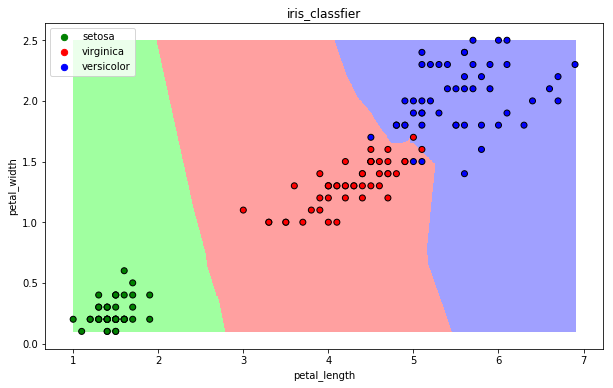
13.2 朴素贝叶斯算法
【1】基本思想
当 X=(x1, x2)发生的时候,哪一个 yk 发生的概率最大
【2】sklearn 实现
构建分类器对象
训练
预测
评估
可视化

13.3 决策树算法
【1】基本思想
CART 算法:每次通过一个特征,将数据尽可能的分为纯净的两类,递归的分下去
【2】sklearn 实现
构建分类器对象
训练
预测
评估
可视化
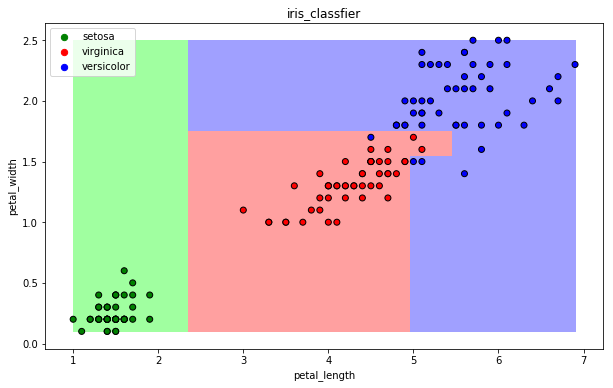
13.4 逻辑回归算法
【1】基本思想
一种解释:
训练:通过一个映射方式,将特征 X=(x1, x2) 映射成 P(y=ck), 求使得所有概率之积最大化的映射方式里的参数
预测:计算 p(y=ck) 取概率最大的那个类别作为预测对象的分类
【2】sklearn 实现
构建分类器对象
训练
预测
评估
可视化

13.5 支持向量机算法
【1】基本思想
以二分类为例,假设数据可用完全分开:
用一个超平面将两类数据完全分开,且最近点到平面的距离最大
【2】sklearn 实现
构建分类器对象
训练
预测
评估
可视化
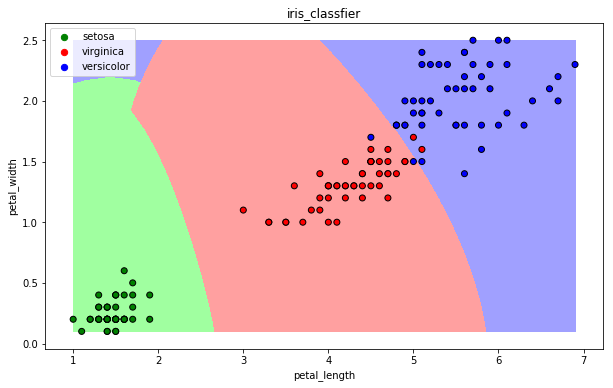
13.6 集成方法——随机森林
【1】基本思想
训练集 m,有放回的随机抽取 m 个数据,构成一组,共抽取 n 组采样集
n 组采样集训练得到 n 个弱分类器 弱分类器一般用决策树或神经网络
将 n 个弱分类器进行组合得到强分类器
【2】sklearn 实现
构建分类器对象
训练
预测
评估
可视化
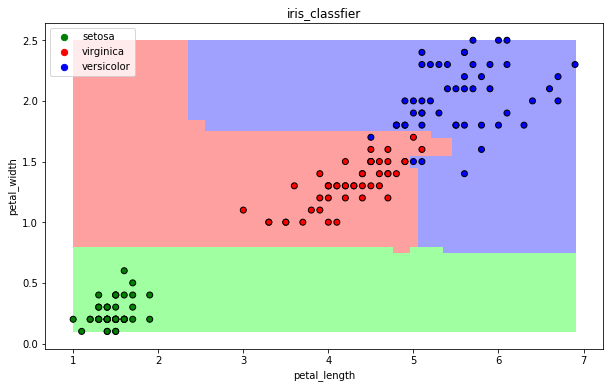
13.7 集成方法——Adaboost
【1】基本思想
训练集 m,用初始数据权重训练得到第一个弱分类器,根据误差率计算弱分类器系数,更新数据的权重
使用新的权重训练得到第二个弱分类器,以此类推
根据各自系数,将所有弱分类器加权求和获得强分类器
【2】sklearn 实现
构建分类器对象
训练
预测
评估
可视化
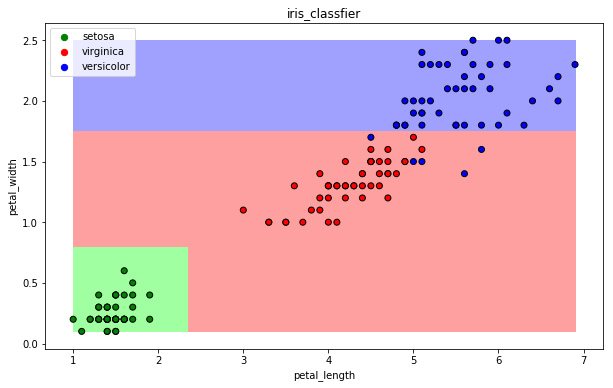
13.8 集成方法——梯度提升树 GBDT
【1】基本思想
训练集 m,获得第一个弱分类器,获得残差,然后不断地拟合残差
所有弱分类器相加得到强分类器
【2】sklearn 实现
构建分类器对象
训练
预测
评估
可视化
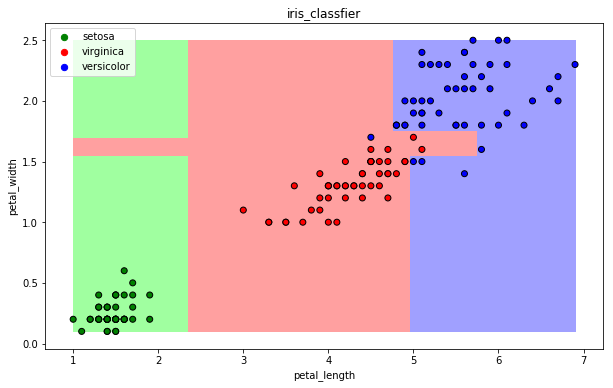
13.9 常用方法
【1】xgboost
GBDT 的损失函数只对误差部分做负梯度(一阶泰勒)展开
XGBoost 损失函数对误差部分做二阶泰勒展开,更加准确,更快收敛
【2】lightgbm
微软:快速的,分布式的,高性能的基于决策树算法的梯度提升框架
速度更快
【3】stacking
堆叠或者叫模型融合
先建立几个简单的模型进行训练,第二级学习器会基于前级模型的预测结果进行再训练
【4】神经网络
版权声明: 本文为 InfoQ 作者【timerring】的原创文章。
原文链接:【http://xie.infoq.cn/article/f276697fc5d1146610f3eee05】。未经作者许可,禁止转载。











评论